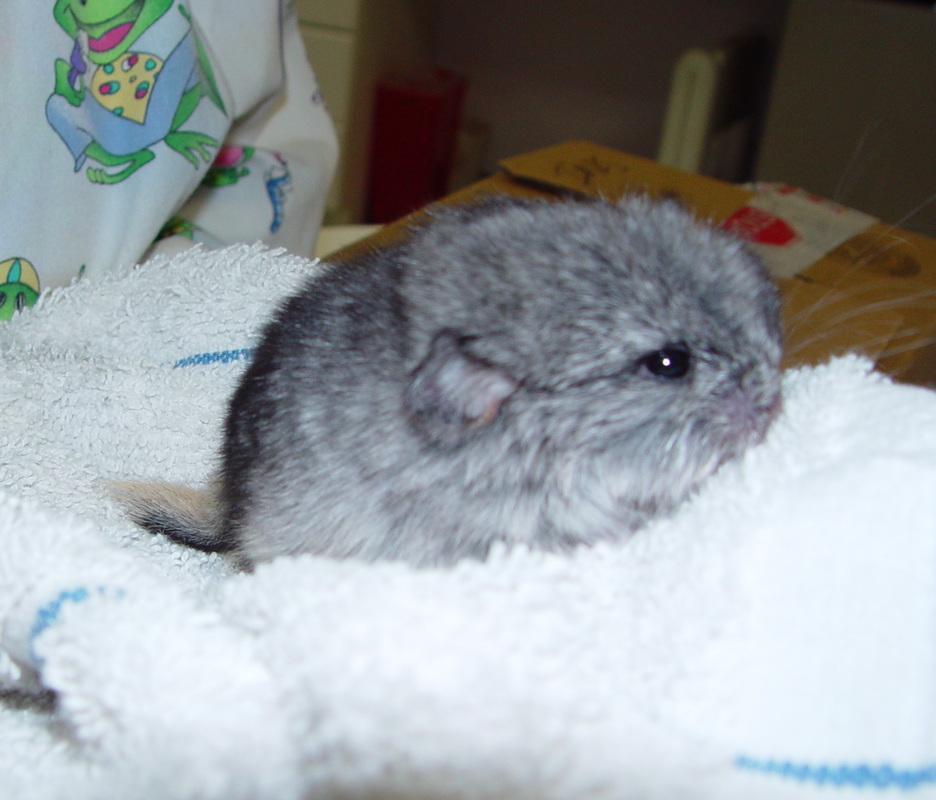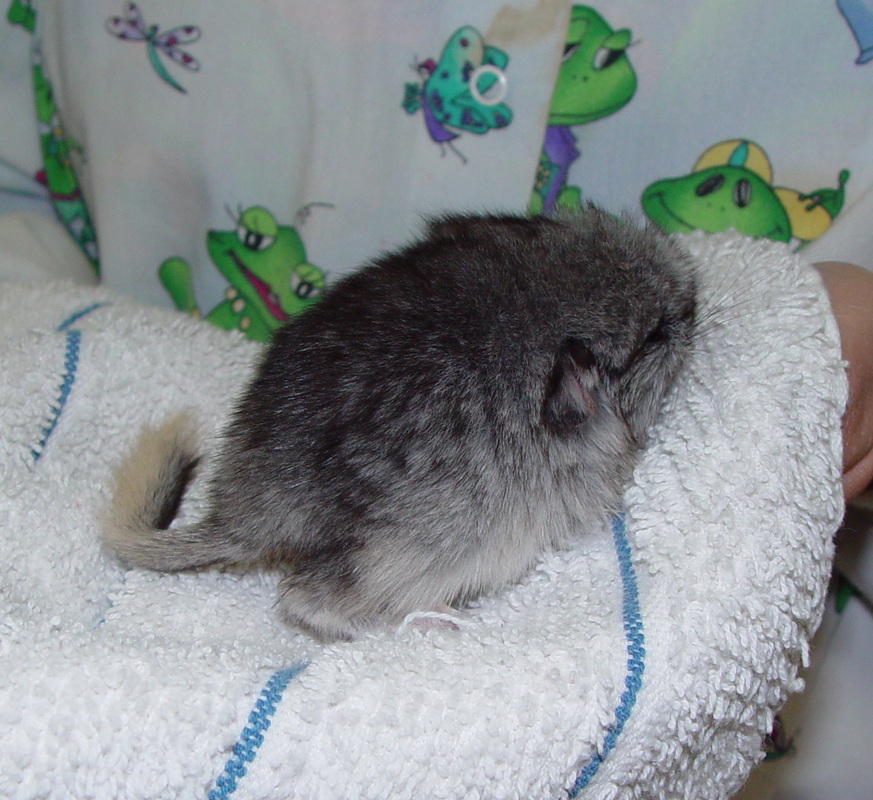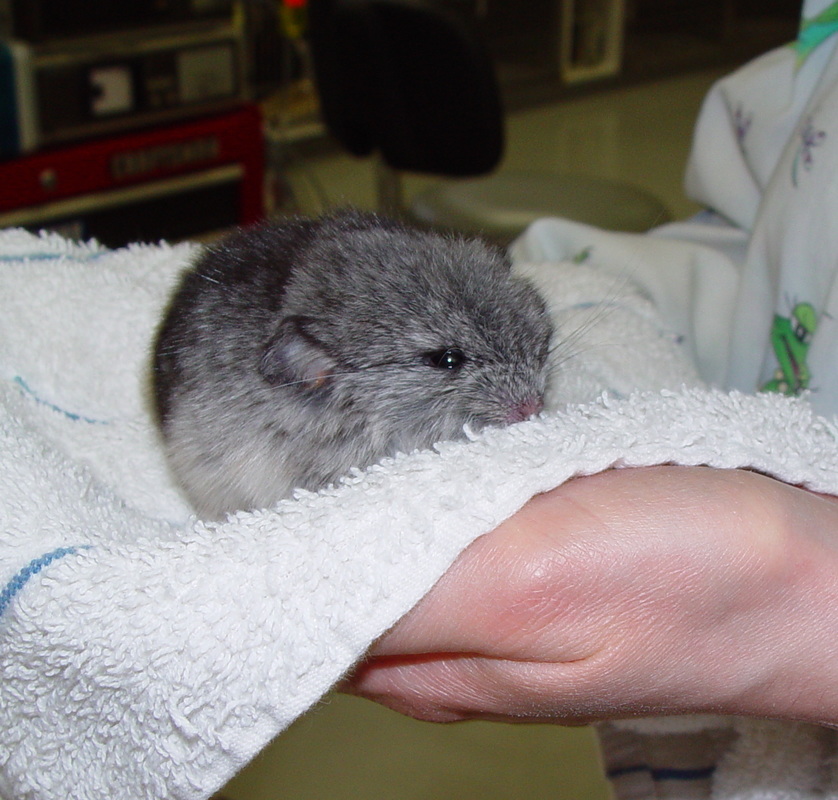Chinchilla Care
by Jessi O’Connell, CVT
Photos and edited by Susan Horton, DVM
Photos and edited by Susan Horton, DVM
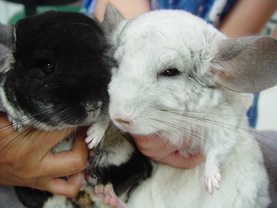
General Characteristics
Chinchillas are rodents, characterized by their large hind feet, chubby round bodies, soft dense fur, large eyes and ears, long whiskers, and squirrel-like tails. Chinchilla lanigera, with a longer tail, is the most common species, while Chinchilla brevicaudata has a very short tail.
Chinchillas as Pets
Chinchillas are very beautiful animals coming in many different color morphs ranging from the standard grey to the white or ebony mosaic. They make great pets because they are social, intelligent, clean, and very entertaining. Chinchillas have very little odor as long as you keep up on cages cleaning. Chinchillas have a life span of approximately 10-15 years. One important factor to consider when planning on getting a pet chinchilla is that they are nocturnal. This means that they are usually awake from dusk until dawn. And sleep most of the day. Therefore if you’re looking for a pet for your kids they may not be ideal.
Pet Appeal
Chinchillas have appealing, affectionate personalities, and are intelligent, charming creatures that quickly bond to their owners. These fast, agile climbers seem to have a sense of humor as they entertain their families with their antics. Chinchillas can make great pets, because they are easy to care for, have very little odor and rarely bite.
Diet
Chinchillas are nocturnal and consume most of their food overnight. Your pet should have unlimited access to hay available as their primary food source. They should have a mix of Alfalfa and Timothy hay until they are six months old. After six months of age they should have Oxbow Timothy hay as their main hay source. Orchard, Oat, or Brome hay can be given in small amount along with the Timothy hay. 1-2 tablespoons of Alfalfa Based chinchilla pellets should be given daily. The pelleted diet should not contain any seeds or nuts as these are fattening fillers with no nutritional value. Approximately one cup of fresh greens should be offered daily. Greens to avoid are Broccoli, Spinach, kale, and other cruciferous greens.
Sexing
The anogenital distance in males is about twice as long as in females. Male chinchillas do not have a scrotum, and the testes remain primarily in the abdominal cavity. In females, the anus is immediately caudal to the cone-shaped urethral papilla (urinary and reproductive opening). The female vagina is normally sealed by a membrane except during estrus (3-5 days) and parturition. If a female chinchilla is not bred at a young age, her pelvis will fuse and she may have difficulty giving birth later. The female gives birth to up to four young, but usually two at a time. The young are born fully furred and ready to explore the world! It is always safest to have your pet sexed at the veterinarian before introducing it to another chinchilla.
Chinchillas are rodents, characterized by their large hind feet, chubby round bodies, soft dense fur, large eyes and ears, long whiskers, and squirrel-like tails. Chinchilla lanigera, with a longer tail, is the most common species, while Chinchilla brevicaudata has a very short tail.
Chinchillas as Pets
Chinchillas are very beautiful animals coming in many different color morphs ranging from the standard grey to the white or ebony mosaic. They make great pets because they are social, intelligent, clean, and very entertaining. Chinchillas have very little odor as long as you keep up on cages cleaning. Chinchillas have a life span of approximately 10-15 years. One important factor to consider when planning on getting a pet chinchilla is that they are nocturnal. This means that they are usually awake from dusk until dawn. And sleep most of the day. Therefore if you’re looking for a pet for your kids they may not be ideal.
Pet Appeal
Chinchillas have appealing, affectionate personalities, and are intelligent, charming creatures that quickly bond to their owners. These fast, agile climbers seem to have a sense of humor as they entertain their families with their antics. Chinchillas can make great pets, because they are easy to care for, have very little odor and rarely bite.
Diet
Chinchillas are nocturnal and consume most of their food overnight. Your pet should have unlimited access to hay available as their primary food source. They should have a mix of Alfalfa and Timothy hay until they are six months old. After six months of age they should have Oxbow Timothy hay as their main hay source. Orchard, Oat, or Brome hay can be given in small amount along with the Timothy hay. 1-2 tablespoons of Alfalfa Based chinchilla pellets should be given daily. The pelleted diet should not contain any seeds or nuts as these are fattening fillers with no nutritional value. Approximately one cup of fresh greens should be offered daily. Greens to avoid are Broccoli, Spinach, kale, and other cruciferous greens.
Sexing
The anogenital distance in males is about twice as long as in females. Male chinchillas do not have a scrotum, and the testes remain primarily in the abdominal cavity. In females, the anus is immediately caudal to the cone-shaped urethral papilla (urinary and reproductive opening). The female vagina is normally sealed by a membrane except during estrus (3-5 days) and parturition. If a female chinchilla is not bred at a young age, her pelvis will fuse and she may have difficulty giving birth later. The female gives birth to up to four young, but usually two at a time. The young are born fully furred and ready to explore the world! It is always safest to have your pet sexed at the veterinarian before introducing it to another chinchilla.
Housing
The minimal cage size is 3’x 2’ x 18” deep. An escape proof wire cage with a solid metal floor is optimal. Chinchillas shouldn’t be exposed to a wire floor because this can lead to ulcerative pressure sores on their feet. Also wire grates can potentially lead to limb fracture if the chinchilla’s leg gets caught. Bedding options include Carefresh, aspen shavings, or fleece bedding. Avoid using cedar shavings as the aromatic phenols in the wood are toxic to chinchillas. Cages should be cleaned daily to keep an accurate account of fecal production. To simulate their natural environment the cage should have many ledges and levels, as well as a hide box. Also beware of ladders in your pets cage as these should be solid ramps to prevent limb fracture. Always have a fixed food bowl that your pet can not turn over and a glass water bottle. Glass water bottles should be cleaned daily and put through the dish washer at least once a week. Chinchillas teeth grow continuously throughout their life, so wood chew toys should always be readily available to your pet. Some chinchilla safe woods are aspen, apple wood, bamboo, pear wood, willow, manzanita, hazelnut, and poplar. Chinchillas are very active and in general love having a wheel in their cage. However making sure that the wheel is suitable for them, is of great importance. The wheel should be at least a 15” in diameter and solid with no spokes or cross bars. Spokes in the middle of the wheel cab cause back trauma, while cross bars can lead to broken limbs. Their cage should be kept out of direct sunlight and away from drafts. The temperature in the room should ideally be in the 60-70 degrees F range and with a humidity level around 40%. Temperatures exceeding 80 degrees F can lead to heat stroke which can be fatal. Signs of hyperthermia are lethargy, rapid and shallow respirations, hypersalivation, and weakness. If you see any of these signs contact your veterinarian immediately. Chinchillas are social animals that live in herds in the wild; this is why group housing is recommended. If you chose to use group housing make sure you have a same sex pair or altered sex pairs. If chinchillas are not housed together from a young age be very careful when you introduce them. Always perform introductions very slowly over a long period of time and under supervision. Chinchillas can be territorial so use a neutral environment for introductions.
Dust Bathing
Chinchillas have very dense fur that contains anywhere from 60-90 loosely attached hairs per hair follicle. In the wild, chinchillas roll in volcanic ash to remove oil from their fur. Excessive oil can lead to matted fur which creates poor insulation from the elements. Dust baths, along with proper humidity (around 40%), help to prevent these mats from occurring in captivity. Dust bathing should be done outside of the cage in a well ventilated area. Dust can be obtained from many commercial pet retailers as well as online sources. Two commonly used brands are Blue Sparkle and Blue Cloud. Put approximately one inch of chinchilla dust into a dust house, pan, or similar container large enough for them to roll in. Chinchillas should have access to a dust bath three times weekly for 15-20 minutes. Never leave the dust pan in their cage with them, because excessive dust bathing can lead to conjunctivitis. It is also important to keep the dust as clean and free of feces and urine as possible. Using a dirty dust house can easily spread bacterial and fungal infections.
The minimal cage size is 3’x 2’ x 18” deep. An escape proof wire cage with a solid metal floor is optimal. Chinchillas shouldn’t be exposed to a wire floor because this can lead to ulcerative pressure sores on their feet. Also wire grates can potentially lead to limb fracture if the chinchilla’s leg gets caught. Bedding options include Carefresh, aspen shavings, or fleece bedding. Avoid using cedar shavings as the aromatic phenols in the wood are toxic to chinchillas. Cages should be cleaned daily to keep an accurate account of fecal production. To simulate their natural environment the cage should have many ledges and levels, as well as a hide box. Also beware of ladders in your pets cage as these should be solid ramps to prevent limb fracture. Always have a fixed food bowl that your pet can not turn over and a glass water bottle. Glass water bottles should be cleaned daily and put through the dish washer at least once a week. Chinchillas teeth grow continuously throughout their life, so wood chew toys should always be readily available to your pet. Some chinchilla safe woods are aspen, apple wood, bamboo, pear wood, willow, manzanita, hazelnut, and poplar. Chinchillas are very active and in general love having a wheel in their cage. However making sure that the wheel is suitable for them, is of great importance. The wheel should be at least a 15” in diameter and solid with no spokes or cross bars. Spokes in the middle of the wheel cab cause back trauma, while cross bars can lead to broken limbs. Their cage should be kept out of direct sunlight and away from drafts. The temperature in the room should ideally be in the 60-70 degrees F range and with a humidity level around 40%. Temperatures exceeding 80 degrees F can lead to heat stroke which can be fatal. Signs of hyperthermia are lethargy, rapid and shallow respirations, hypersalivation, and weakness. If you see any of these signs contact your veterinarian immediately. Chinchillas are social animals that live in herds in the wild; this is why group housing is recommended. If you chose to use group housing make sure you have a same sex pair or altered sex pairs. If chinchillas are not housed together from a young age be very careful when you introduce them. Always perform introductions very slowly over a long period of time and under supervision. Chinchillas can be territorial so use a neutral environment for introductions.
Dust Bathing
Chinchillas have very dense fur that contains anywhere from 60-90 loosely attached hairs per hair follicle. In the wild, chinchillas roll in volcanic ash to remove oil from their fur. Excessive oil can lead to matted fur which creates poor insulation from the elements. Dust baths, along with proper humidity (around 40%), help to prevent these mats from occurring in captivity. Dust bathing should be done outside of the cage in a well ventilated area. Dust can be obtained from many commercial pet retailers as well as online sources. Two commonly used brands are Blue Sparkle and Blue Cloud. Put approximately one inch of chinchilla dust into a dust house, pan, or similar container large enough for them to roll in. Chinchillas should have access to a dust bath three times weekly for 15-20 minutes. Never leave the dust pan in their cage with them, because excessive dust bathing can lead to conjunctivitis. It is also important to keep the dust as clean and free of feces and urine as possible. Using a dirty dust house can easily spread bacterial and fungal infections.
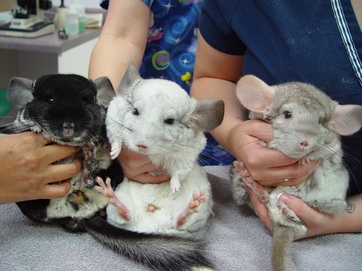
Diet
Chinchillas are nocturnal and consume most of their food overnight. Your pet should have unlimited access to hay available as their primary food source. They should have a mix of Alfalfa and Timothy hay until they are six months old. After six months of age they should have Oxbow Timothy hay as their main hay source. Orchard, Oat, or Brome hay can be given in small amount along with the Timothy hay. 1-2 tablespoons of Alfalfa Based chinchilla pellets should be given daily. The pelleted diet should not contain any seeds or nuts as these are fattening fillers with no nutritional value. Approximately one cup of fresh greens should be offered daily. Greens to avoid are Broccoli, Spinach, kale, and other cruciferous greens.
By studying chinchillas in their natural environments, we know they eagerly seek out berries, herbs and cactus fruits as well as high-fiber foods such as grasses and the bark of small shrubs and bushes. In order for nutrients to be extracted, this diet requires a large volume of food intake and prolonged chewing, both of which are important factors in maintaining the chinchilla's gastrointestinal and dental health. In captivity it has been shown that chinchillas ingest most of their food at night and are selective feeders; when given the choice, they will select the most tender, succulent plant parts first. If not controlled, this high energy, low fiber intake will lead to obesity.
Based on our dietary knowledge of the wild chinchilla, together with studies measuring the nutritional intake of the pet chinchilla it has been determined that the pet chinchilla does best on a diet composed of free-choice (available all-the-time) hay and a small daily ration of pellets. This diet meets the chinchilla's fiber and energy needs without causing obesity. These nutritional requirements can be fulfilled by feeding your pet chinchilla free-choice grass hay (Oxbow's Western Timothy, Oat, Orchard or Brome) or legume hay (Oxbow's Alfalfa Nibbles) along with a daily ration of 1-2 tablespoons (15-30 grams) of pellets. By providing extra energy, protein, vitamins and minerals, pellets play an important role in ensuring the nutritional balance of your chinchilla's diet. Fresh greens should be offered daily, about 1 cup.
In addition to meeting nutritional requirements, the high-roughage diet we recommend is critical in helping to prevent two of the most common health disorders seen in these animals: dental disease and gastrointestinal disease. We can mimic the chinchilla's natural high-roughage diet by feeding hay as the primary food source. Like the rabbit and guinea pig, the chinchilla is a hindgut fermentor, meaning it digests much of its food in the cecum and colon (large intestine), which make up the end of the digestive tract. In the chinchilla, the cecum ("appendix" in humans) is a large blind-ended sac located at the junction of the small and large intestine. Inside the chinchilla's cecum, specific bacterial populations aid digestion of foods. Fiber is necessary for these bacterial populations to stay in balance and function properly. Fiber also stimulates gastrointestinal motility, which allows ingested food to move along properly for normal digestion. Without fiber, the gastrointestinal tract slows down, resulting in changes in cecal pH, fermentation capabilities and microorganism populations. Over time, these disruptive changes can result in various forms of chinchilla indigestion: gastrointestinal stasis, constipation or diarrhea. The chinchilla with gastrointestinal stasis will be anorexic or have a reduced appetite and will produce very small stools there will be none at all. The chinchilla with constipation will strain to defecate, and the few fecal pellets passed will be thin, short, round and occasionally blood-stained. The chinchilla with diarrhea may or may not have a reduced appetite and will pass soft stools that frequently matt the fur around the anus. Again, these forms of chinchilla gastrointestinal upset are commonly associated with inappropriate diets- that is, diets that contain excess amounts of grains, seeds and/or fresh greens without significant roughage or fiber.
Chinchillas are nocturnal and consume most of their food overnight. Your pet should have unlimited access to hay available as their primary food source. They should have a mix of Alfalfa and Timothy hay until they are six months old. After six months of age they should have Oxbow Timothy hay as their main hay source. Orchard, Oat, or Brome hay can be given in small amount along with the Timothy hay. 1-2 tablespoons of Alfalfa Based chinchilla pellets should be given daily. The pelleted diet should not contain any seeds or nuts as these are fattening fillers with no nutritional value. Approximately one cup of fresh greens should be offered daily. Greens to avoid are Broccoli, Spinach, kale, and other cruciferous greens.
By studying chinchillas in their natural environments, we know they eagerly seek out berries, herbs and cactus fruits as well as high-fiber foods such as grasses and the bark of small shrubs and bushes. In order for nutrients to be extracted, this diet requires a large volume of food intake and prolonged chewing, both of which are important factors in maintaining the chinchilla's gastrointestinal and dental health. In captivity it has been shown that chinchillas ingest most of their food at night and are selective feeders; when given the choice, they will select the most tender, succulent plant parts first. If not controlled, this high energy, low fiber intake will lead to obesity.
Based on our dietary knowledge of the wild chinchilla, together with studies measuring the nutritional intake of the pet chinchilla it has been determined that the pet chinchilla does best on a diet composed of free-choice (available all-the-time) hay and a small daily ration of pellets. This diet meets the chinchilla's fiber and energy needs without causing obesity. These nutritional requirements can be fulfilled by feeding your pet chinchilla free-choice grass hay (Oxbow's Western Timothy, Oat, Orchard or Brome) or legume hay (Oxbow's Alfalfa Nibbles) along with a daily ration of 1-2 tablespoons (15-30 grams) of pellets. By providing extra energy, protein, vitamins and minerals, pellets play an important role in ensuring the nutritional balance of your chinchilla's diet. Fresh greens should be offered daily, about 1 cup.
In addition to meeting nutritional requirements, the high-roughage diet we recommend is critical in helping to prevent two of the most common health disorders seen in these animals: dental disease and gastrointestinal disease. We can mimic the chinchilla's natural high-roughage diet by feeding hay as the primary food source. Like the rabbit and guinea pig, the chinchilla is a hindgut fermentor, meaning it digests much of its food in the cecum and colon (large intestine), which make up the end of the digestive tract. In the chinchilla, the cecum ("appendix" in humans) is a large blind-ended sac located at the junction of the small and large intestine. Inside the chinchilla's cecum, specific bacterial populations aid digestion of foods. Fiber is necessary for these bacterial populations to stay in balance and function properly. Fiber also stimulates gastrointestinal motility, which allows ingested food to move along properly for normal digestion. Without fiber, the gastrointestinal tract slows down, resulting in changes in cecal pH, fermentation capabilities and microorganism populations. Over time, these disruptive changes can result in various forms of chinchilla indigestion: gastrointestinal stasis, constipation or diarrhea. The chinchilla with gastrointestinal stasis will be anorexic or have a reduced appetite and will produce very small stools there will be none at all. The chinchilla with constipation will strain to defecate, and the few fecal pellets passed will be thin, short, round and occasionally blood-stained. The chinchilla with diarrhea may or may not have a reduced appetite and will pass soft stools that frequently matt the fur around the anus. Again, these forms of chinchilla gastrointestinal upset are commonly associated with inappropriate diets- that is, diets that contain excess amounts of grains, seeds and/or fresh greens without significant roughage or fiber.
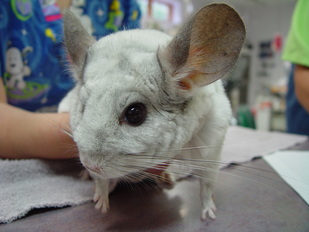
Dental problems, such as malocclusion, molar root overgrowth and molar spur, are also common in chinchillas. As in the rabbit and guinea pig, all of the chinchilla's teeth grow continuously. Improper wearing of the teeth secondary to a diet low in fiber and the lack of suitable chewing materials can result in sharp points on the upper and/or lower molars, resulting in painful ulcers on the cheek and/or tongue. The chinchilla with dental problems often has a depressed appetite, and you may observe food dropping from its mouth as it attempts to chew. Irritation from the molar spurs may also cause increased salivation, which results in a wet matted chin (a syndrome also known as "slobbers"). Providing plenty of free-choice hay ensures a normal chewing pattern, thus encouraging normal dental wear.
Chinchillas can thrive on either grass or legume hay. Veterinary nutritionists and clinicians usually recommend feeding as assortment of grass hays free choice.
When it comes to feeding a concentrated ration, we recommend alfalfa-based pellets that contain more than 18% crude fiber and a minimum of 10% protein. Oxbow Pet Products' Chinchilla Deluxe provides a good balance of fiber, protein, carbohydrates, vitamins and mineral and is the pellet diet of choice for your pet chinchilla. As a general rule, we recommend feeding 2 tablespoons (30 grams) of pellets to each adult chinchilla on a daily basis. The quantity of pellets fed to growing and pregnant or lactating chinchillas should be increased to approximately ½ cup or more per day. Conversion from a seed/pellet mixture to this highly palatable pellet is usually simple, but a gradual conversion over a period of one to two weeks is recommended in order to prevent digestive upset.
Treats such as fresh vegetables or herbs can be offered but should be fed in limited quantities. A diet containing too many vegetables can result in diarrhea and gastrointestinal upset. Therefore, we recommend a daily regimen of no more than 1 cup of herbs (mint, basil, oregano, cilantro or thyme) or leafy green vegetables (romaine, butter crunch or red leaf lettuce, carrot tops or dandelion greens) for your chinchilla. Feed the same foods consistently in order to prevent digestive upset, and avoid gas-forming vegetables such as broccoli and cauliflower.
It is obvious that nutrition plays a key role in keeping your pet chinchilla healthy. Fiber is of utmost importance in preventing gastrointestinal upset and dental problems, two of the most common health issues plaguing the pet chinchilla. Offering your chinchilla a continuous supply of timothy hay, is one of the best ways to ensure adequate fiber intake. Be consistent with the amount of pellets fed and the type and quantity of treats offered. Your chinchilla's digestive tract thrives on consistency, and your reward will be a pet that is active, bright, alert and healthy.
Chinchillas can thrive on either grass or legume hay. Veterinary nutritionists and clinicians usually recommend feeding as assortment of grass hays free choice.
When it comes to feeding a concentrated ration, we recommend alfalfa-based pellets that contain more than 18% crude fiber and a minimum of 10% protein. Oxbow Pet Products' Chinchilla Deluxe provides a good balance of fiber, protein, carbohydrates, vitamins and mineral and is the pellet diet of choice for your pet chinchilla. As a general rule, we recommend feeding 2 tablespoons (30 grams) of pellets to each adult chinchilla on a daily basis. The quantity of pellets fed to growing and pregnant or lactating chinchillas should be increased to approximately ½ cup or more per day. Conversion from a seed/pellet mixture to this highly palatable pellet is usually simple, but a gradual conversion over a period of one to two weeks is recommended in order to prevent digestive upset.
Treats such as fresh vegetables or herbs can be offered but should be fed in limited quantities. A diet containing too many vegetables can result in diarrhea and gastrointestinal upset. Therefore, we recommend a daily regimen of no more than 1 cup of herbs (mint, basil, oregano, cilantro or thyme) or leafy green vegetables (romaine, butter crunch or red leaf lettuce, carrot tops or dandelion greens) for your chinchilla. Feed the same foods consistently in order to prevent digestive upset, and avoid gas-forming vegetables such as broccoli and cauliflower.
It is obvious that nutrition plays a key role in keeping your pet chinchilla healthy. Fiber is of utmost importance in preventing gastrointestinal upset and dental problems, two of the most common health issues plaguing the pet chinchilla. Offering your chinchilla a continuous supply of timothy hay, is one of the best ways to ensure adequate fiber intake. Be consistent with the amount of pellets fed and the type and quantity of treats offered. Your chinchilla's digestive tract thrives on consistency, and your reward will be a pet that is active, bright, alert and healthy.
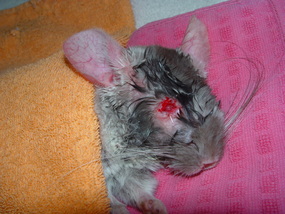 A chin with severe conjunctivitis
A chin with severe conjunctivitis
Handling
There are two safe ways of handling your pet chinchilla. The first is to scoop the chinchilla and lift it up with one hand under the abdomen and the second under their rump. Always use your body as a support for their backs. The second method is only useful when you must retrieve a very scared animal from their cage. Place a towel over the chinchilla then wrap it around them. Place one hand under the abdomen of the wrapped chinchilla and hold them against your body. We use this method for scared chinchillas to help prevent fur slip, which is a defense mechanism where patches of fur fall out during restraint.
What the Owner Needs to Know About Chinchillas
Common Clinical Syndromes
Seek medical attention if:
Trauma – If your chinchilla has had a traumatic episode such as a fall or getting caught in the cage. They could have a bone fracture or break which would need medical attention.
Anorexia – If your chinchilla has a decreased appetite, and or stool production. Or your chinchilla has stopped eating or producing stools. It is an emergency and they need to bee seen.
Heat Stroke – Temperature over 80 degrees F and your chinchilla isn’t acting normal, call your veterinarian.
Diarrhea/Constipation – Can lead to dehydration and or GI stasis. Call your veterinarian immediately to have them determine if you need to come in urgently.
Drooling – If your chinchilla is drooling it should be seen by a veterinarian as soon as possible, as it can be a sign of dental disease.
If you have any questions, please feel free to call us at 847-329-8709.
There are two safe ways of handling your pet chinchilla. The first is to scoop the chinchilla and lift it up with one hand under the abdomen and the second under their rump. Always use your body as a support for their backs. The second method is only useful when you must retrieve a very scared animal from their cage. Place a towel over the chinchilla then wrap it around them. Place one hand under the abdomen of the wrapped chinchilla and hold them against your body. We use this method for scared chinchillas to help prevent fur slip, which is a defense mechanism where patches of fur fall out during restraint.
What the Owner Needs to Know About Chinchillas
- Temperature higher than 82° F can be fatal (optimal 50-68° F)
- Keep dry (40% or less humidity)
- Dogs, cats and ferrets are predators
- Basically nocturnal, but can be active during day as well
- Need at least 30 minutes each day for an exercise/play with owner
- Bite aggressively only if restrained against their will
- Often difficult to litter-train
- Don't bathe in water, use dust baths 5 minutes 3 times weekly
Common Clinical Syndromes
- Dermatophytosis
- Trauma (broken bones, wounds)
- Diarrhea/constipation
- Respiratory disorders
- Eye irritation/conjunctivitis
- Convulsions/encephalitis/lead poisoning
- Malocclusion
- Penile hair rings in males/paraphimosis
- "Fur-barbering" from stress
- Heat stroke
- Choke/bloat
- Cardiomyopathy
- Diabetes Mellitus
Seek medical attention if:
Trauma – If your chinchilla has had a traumatic episode such as a fall or getting caught in the cage. They could have a bone fracture or break which would need medical attention.
Anorexia – If your chinchilla has a decreased appetite, and or stool production. Or your chinchilla has stopped eating or producing stools. It is an emergency and they need to bee seen.
Heat Stroke – Temperature over 80 degrees F and your chinchilla isn’t acting normal, call your veterinarian.
Diarrhea/Constipation – Can lead to dehydration and or GI stasis. Call your veterinarian immediately to have them determine if you need to come in urgently.
Drooling – If your chinchilla is drooling it should be seen by a veterinarian as soon as possible, as it can be a sign of dental disease.
If you have any questions, please feel free to call us at 847-329-8709.
